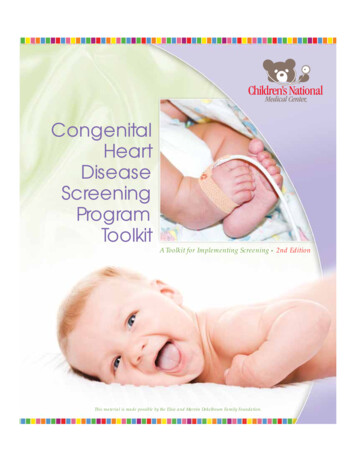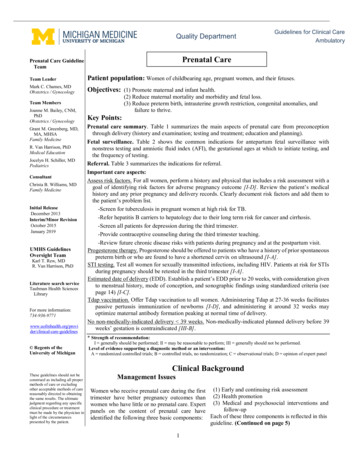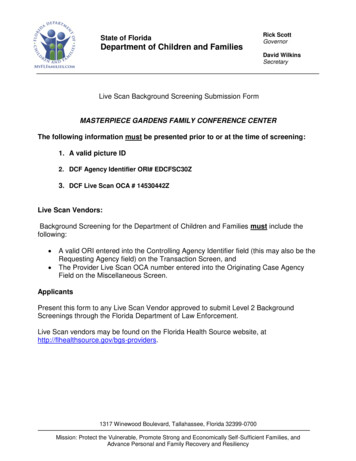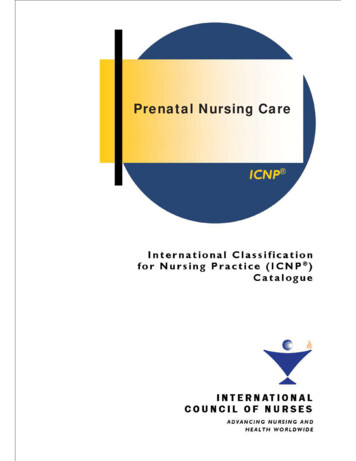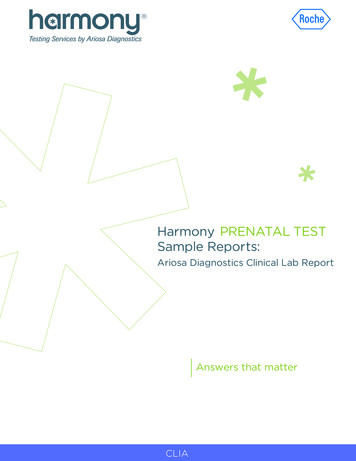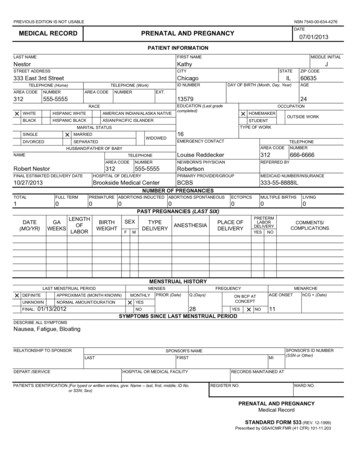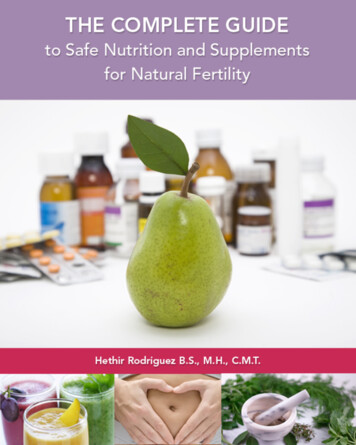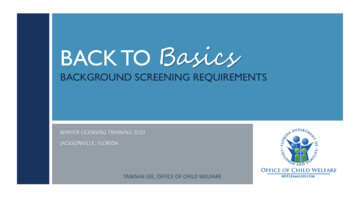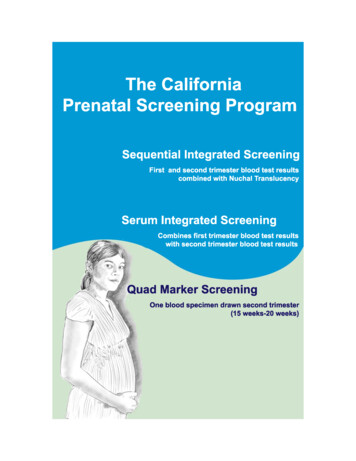
Transcription
The California Prenatal Screening Program is voluntary.Women can refuse testing without losing insurance benefits oreligibility or services from State Programs.California law prohibits the use of test results by insurancecompanies or employers to discriminate against an individual.If you believe that you have experienced discrimination asa result of prenatal screening, write to Chief of theGenetic Disease Screening Program, at the address below.California Department of Public HealthGenetic Disease Screening Program850 Marina Bay Parkway, F175Richmond, CA 94804866-718-7915 toll freeFor more information visit our website: www.cdph.ca.gov oremail us: pns@cdph.ca.govMarch 2017
The CaliforniaPrenatal Screening ProgramTable of ContentsThe California Prenatal Screening Program. 2Blood Tests are Part of Prenatal Screening. 3Three Types of Screening Tests. 4Summary of Prenatal Screening Tests. 5The Types of Screening Results. 6Test Results and Follow-Up Services. 7Birth Defects. 9Diagnostic Tests Instead of Screening Tests. 11Program Fee. 12Consent and Research. 13Patient Consent/Decline Form. 14Environmental Health Information. 18Information About Cord Blood Banking. 19Notice of Information and Privacy Practices. 21The California Newborn Screening Test. Back Cover
The California Prenatal Screening ProgramChecking a Baby’s Health Before BirthDuring pregnancy, it is important to know as muchas possible about the health of the developing baby.For some women, this means testing for birthdefects. Babies can be born with birth defects evenwhen the mother is healthy. The CaliforniaPrenatal Screening Program can help detect somebirth defects such as:Down syndrome.a cause of intellectual disabilityTrisomy 18 .intellectual disability andsevere physical birth defectsTrisomy 13.intellectual disability andsevere physical birth defectsNeural tube defects.such as spina bifida (open spine)Abdominal wall defects .the baby’s intestines are outside the bodySmith-Lemli-Opitz syndrome .SLOS is a very rare condition causingintellectual disability and physical birth defectsA screening test estimates the chance (risk) that the baby has certain birthdefects. This is called a “Risk Assessment”. If the risk is high, a woman maythen choose to have advanced screening or diagnostic tests that confirm orrule out most birth defects.See pages 9 -10 for a description of these birth defectsREMEMBER, it is a woman's decision whether to have prenatalscreening tests. A Consent or Decline form is on pages 14-17.2
Blood Tests are Part of Prenatal ScreeningA small amount of blood is taken from the pregnant woman’sarm and sent to the Program. At different times duringpregnancy, her blood is tested for substances such as:PAPP-A . .Pregnancy Associated Plasma Protein AhCG . .Human Chorionic GonadotropinAFP . Alpha-FetoproteinuE3 . .Unconjugated EstriolInhibin.Dimeric Inhibin-A (DIA)These substances are made by the pregnant woman and herunborn baby. At each week of pregnancy, there are differentexpected amounts of these substances in the mother’s blood.Other information used for the screening test includes age, raceand weight.Blood test results are sent toa woman's doctor or clinic7 to 10 days after blood draw.Based on her week ofpregnancy, a woman and herdoctor can choose which typeof screening is best for her.Screening TimelineFirst TrimesterBlood Draw.910111213Second TrimesterBlood Draw14NuchalTranslucency151617181920 .40 weeksGestation in Weeks
The California Prenatal Screening ProgramOffers Three Types of Screening TestsSequential Integrated ScreeningFirst Trimester Risk AssessmentA fi rst trimester blood specimen is drawn at 10 weeks 0 days –13 weeks 6 days of pregnancy. A Nuchal Translucency*(NT) ultrasound isdone between 11 weeks 2 days and 14 weeks 2 days of pregnancy. Apreliminary risk assessment is provided for Down syndrome andTrisomy 18.Second Trimester Risk AssessmentA second trimester blood specimen is drawn at 15 weeks 0 days –20 weeks 0 days of pregnancy. These test results are combined withthe first trimester test results and NT ultrasound. New risk assessmentis provided for Down syndrome and Trisomy 18. Risk assessment isalso provided for neural tube defects and SLOS.Serum Integrated Screening (No NT ultrasound)A first trimester blood specimen is drawn at 10 weeks 0 days –13 weeks 6 days of pregnancy. A second trimester blood test isdrawn at 15 weeks – 20 weeks. The results of the two blood tests arecombined. Risk assessment is reported, only in the second trimester,for Down syndrome, Trisomy 18, neural tube defects and SLOS.Quad Marker ScreeningOne blood specimen is drawn at 15 weeks – 20 weeks of pregnancy(second trimester). Risk assessment is reported in the second trimesterfor Down syndrome, Trisomy 18, neural tube defects and SLOS.*Nuchal Translucency (NT) -A type of ultrasound done only by doctorsor technicians with special training. It measures the fluidatthe back ofthe baby's neck. All babies have a collection of fluid,butbabies withDown syndrome and Trisomy 18 tend to have more.You should talk to your doctor about where to go for Nuchal TranslucencyUltrasound. Also talk to your insurance about coverage. This specialultrasound is not provided by the Prenatal Screening Program.4
90 out of 100 Down syndrome81 out of 100 Trisomy 18 97 out of 100 anencephaly80 out of 100 open spina bifida85 out of 100 abdominal wall defects60 out of 100 SLOSFirst blood draw between10 weeks to 13 weeks 6 daysof pregnancy.Two Blood Draws NuchalTranslucencyUltrasoundTwo Blood DrawsOne Blood DrawSequential IntegratedScreeningSerum IntegratedScreeningQuad MarkerScreening80 out of 100 Down syndrome67 out of 100 Trisomy 18 97 out of 100 anencephaly80 out of 100 open spina bifida85 out of 100 abdominal wall defects60 out of 100 SLOSBetween 15 to 20 weeks ofpregnancyBased on your week of pregnancy, you and your doctor can choose which type of screening is best for youSecond blood draw between15 to 20 weeks of pregnancy.85 out of 100 Down syndrome79 out of 100 Trisomy 18 97 out of 100 anencephaly80 out of 100 open spina bifida85 out of 100 abdominal wall defects60 out of 100 SLOSFirst blood draw between10 weeks to 13 weeks 6 daysof pregnancy.Second blood draw between15 to 20 weeks of pregnancy.Nuchal Translucencyultrasound 11 weeks 2 days to14 weeks 2 daysDetection RatesWhen the Test is DoneTest TypeName of Screening TestComparing The Three Types of Prenatal Screening Tests
The Types of Screening ResultsYour results are specific to you and your current pregnancy.Result: Preliminary Risk Assessment - This first trimesterresult means that the risk (chance) of the baby having Down syndromeor Trisomy 18 is low . low enough that the Program does not offerfollow-up tests.Result: Screen Negative - This second trimester result means thatthe risk (chance) of the baby having any of the screened birthdefects is low . low enough that the Program does not offerfollow-up tests.Important: A result of Screen Negative or Preliminary RiskAssessment does not guarantee that there are no birth defects.Prenatal Screening tests cannot detect 100% of these birth defects.See Chart on page 5 to compare detection rates of thethree types of prenatal screening tests.Result: Screen Positive - This means that the risk (chance) ofthe baby having any of these birth defects is higher than usual.The Program offers follow-up tests to look for possible birth defects.Important: A result of Screen Positive does not always meanthat there is a birth defect.Most women with a screen positive result will havenormal follow-up diagnostic tests and healthy babies.6
Test Results and Follow-Up ServicesIf any test is Screen Positive, what happens next?A woman with a Screen Positive result will be called by her doctor orclinic. She will be offered follow up services at a State-approvedPrenatal Diagnosis Center up to 24 weeks of pregnancy.Authorized services are free at a State-approved Prenatal DiagnosisCenter.A woman can decline services at any time. She can accept someservices such as genetic counseling, and decline other services atthe Prenatal Diagnosis Center. Genetic Counseling: The firstserviceawomanreceivesatthe Prenatal Diagnosis Center is genetic counseling. A GeneticCounselor explains the test results and reviews the family medicalhistory. The counselor explains the follow-up tests which may beoffered.A Genetic Counselor helps a woman decidewhether to have diagnostic testing.7
Tests Which May be Offered After Genetic Counseling: Prenatal Cell-free DNA (cfDNA) Screening:This is a blood test using fetal DNA that is found in themother’s blood. Prenatal cfDNA screening is considered to bea very accurate screening test for certain chromosomeabnormalities like Down syndrome and Trisomy 18. This test isoffered at 10 weeks - 24 weeks of pregnancy. CVS (Chorionic Villus Sampling): This may be offered at10-14 weeks of pregnancy. An experiencedState-approved doctor takes a small number of cells from theplacenta. These cells are tested for Down syndrome,Trisomy 18, and other chromosome abnormalities. Ultrasound: A detailed picture of the baby is made usingsound waves. After 15 weeks of pregnancy, a doctor examinesthe baby very closely for birth defects. Amniocentesis: This may be offered after 15 weeks ofpregnancy. An experienced State-approved doctor takes asmall amount of fluid f rom around the baby.Tests are donefor specific birth defects and for Down syndrome,Trisomy18and other chromosome abnormalities.8
Birth Defects Found ThroughDiagnostic TestingDown SyndromeDown syndrome is caused by an extra chromosome #21 (Trisomy 21).Chromosomes are packages of genetic material found in every cell ofthe body. Birth defects can occur when there are too few or too manychromosomes.Down syndrome is a common cause of intellectual disability andbirth defects. Down syndrome can affect babies born to womenof any age. However, as women get older, the chances increase forhaving a baby with Down Syndrome.Trisomy 18Trisomy 18 is caused by an extra chromosome #18. Most babies withTrisomy 18 are lost through miscarriage. Babies born with Trisomy 18have intellectual disability and physical defects.Trisomy 13Trisomy 13 is caused by an extra chromosome #13. Most babies withTrisomy 13 are lost through miscarriage. Babies born with Trisomy 13have intellectual disability and severe physical birth defects.Smith-Lemli-Opitz Syndrome (SLOS), SCDThis is a very rare birth defect. Babies born with Smith-Lemli-Opitzsyndrome (SLOS) cannot make cholesterol normally. Babies born withthis condition have intellectual disability and may have many physicaldefects.Screen Positive results for SLOS can also indicate increased chancesfor Congenital abnormalities and fetal Demise (fetal death).That is why this screening is also called SCD screening.9
Neural Tube Defects (NTD)As a baby is forming, the neural tube extends from the top of thehead to the end of the spine. This develops into thebaby's brain and spinal cord. The neural tube iscompletely formed by 5 weeks after conception.When there is an opening in the spine, it is calledspina bifida. This defect often causes paralysis ofthe baby's legs. It may also cause loss of bowel andbladder control.Anencephaly occurs when most of the brain does notdevelop. This defect causes the death of the baby or newborn.Abdominal Wall DefectsAbdominal Wall Defects (AWD) are problems involving the baby'sabdomen and intestines. These defects happen when the intestinesand other organs are outside the body. Surgery after birth is usuallyperformed to correct the defect.What if diagnostic tests show that the baby has a birth defect?Information will be given to the woman by a doctor or genetic counselorat the Prenatal Diagnosis Center. They will discuss the birth defect, andoptions for the pregnancy. The Program does not pay for any othermedical services after the diagnostic tests. Referrals for specialsupport services for special needs babies are available.There are other birth defects which cannot be detected by the Program.10
Diagnostic Tests Instead of Screening Testsfor Birth DefectsSome women may consider diagnostic tests instead of screening tests.A diagnostic test can tell whether or not the baby actually has a specificbirthdefect. Screening estimates the risk of certain birth defects.Diagnostic tests during pregnancy can include amniocentesis orchorionic villus sampling (CVS). Diagnostic tests done instead of screeningtests are not covered by the Program.Who may want to consider diagnostic testinginstead of screening? women with a medical or family history of inherited conditions women who know that the baby's father has a medical orfamily history of inherited conditions women who are taking certain medicines women who have diabetes prior to pregnancy women with other high risk pregnancies women age 35 and older at deliveryBefore deciding between a screening test and adiagnostic test, you should talk to your doctor ora genetic counselor. Some insurance policiesmay cover genetic counseling. Ask your doctorfor the pamphlet "Prenatal Diagnosis".11
Program FeeWhat is the fee for the Prenatal Screening Program?Presently, the fee is 221.60 Check with your doctor or clinic aboutthe current fee. The fee covers the blood tests and authorizedfollow-up services at a State-approved Prenatal Diagnosis Center.The Program charges 221.60 when: there is one blood test or twothere is one baby or two. The Program fee does not cover: blood draw charges nuchal translucency ultrasoundThe Program mails a bill and insurance form to the patient unlessinsurance information is received with the blood specimen. In mostcases, health insurance companies and HMOs are required to coverthe fees for the screening program after any deductible or co-pay.There is an exception made for self-insured employers. Medi-Calcovers the Program fee.Contact your health insuranceprovider to determine your plan's payment or co-pay forprenatal testing.12
ConsentPlease talk to your doctor about the screening tests described in thisbooklet. If you decide to participate in Prenatal Screening, you do notneed to consent to any specific type of blood screening test. Youonly need to consent to participate in the Prenatal Screening Program.Or, you can decline to participate in the Program.To document either choice, you will need to sign theConsent or Decline form on the next page.ResearchThe California Birth Defects Monitoring Program was created tocollect information on birth defects. This Program helps researchersto identify the causes of birth defects and other health problemsof women and children.The Birth Defects Monitoring Program and the Prenatal ScreeningProgram are both part of the California Department of Public Health.After screening is completed, the Prenatal Screening Program savessome blood specimens and stores them with the Birth DefectsMonitoring Program.The Department of Public Health must approve any research andany use of these specimens by the Birth Defects Monitoring Program.The Department maintains your confidentiality under the laws andregulations that apply.The prenatal screening specimens are valuable for research aboutthe causes and prevention of birth defects. However, you can haveprenatal screening and decline the use of your specimen for researchthrough a check box on the consent form. Declining research will notaffect your health care or test results in any way.13
CLINICIAN COPYMUST BE FILED IN PATIENT CHARTConsent or DeclineCalifornia Prenatal Screening Program1. I have read the information in this booklet (or have had it read to me).2. I understand that:a. The Prenatal Screening Program offers prenatal tests for thedetection of birth defects such as Down syndrome, Trisomy 18,Trisomy 13, Smith-Lemli-Opitz syndrome (SLOS), Neural TubeDefects, and Abdominal Wall Defects. These birth defectscannot be detected 100 % of the time.b. There is a Program fee charged to the patient. This fee may becovered by health insurance. I agree to pay any part of this feenot covered by insurance.c. If the blood test result is Screen Negative, the Program will notpay for any follow-up testing.d. If the blood test result is Screen Positive, I will need to makea decision regarding follow-up diagnostic testing.e. If the baby is found to have a birth defect, the decision tocontinue or terminate the pregnancy is entirely mine.f. There are birth defects that cannot be detected withscreening tests.3. I also understand that:a. Participation in the Prenatal Screening Program is voluntary.I can decline any test at any time.b. Consent to participate in the Program may include Quad, Serumor Sequential Integrated Screening.
Clinician CopyPage 2I consent to participate in the California PrenatalScreening Program. I request that blood be drawnfor Prenatal Screening.YesI Consentto ScreeningI agree that my blood specimen may be used forresearch by the Department of Public Health, orDepartment approved researchers, unless I mark thebox below.I decline the use of my specimen for research.The Department will maintain confidentiality accordingto applicable laws and regulations.Signed DateNoI decline to participate in the California PrenatalScreening Program. I request that blood not be drawnfor Prenatal Screening.I DeclineScreeningSigned Date
PATIENT COPYConsent or DeclineCalifornia Prenatal Screening Program1. I have read the information in this booklet (or have had it read to me).2. I understand that:a. The Prenatal Screening Program offers prenatal tests for thedetection of birth defects such as Down syndrome, Trisomy 18,Trisomy 13, Smith-Lemli-Opitz syndrome (SLOS), Neural TubeDefects, and Abdominal Wall Defects. These birth defectscannot be detected 100 % of the time.b. There is a Program fee charged to the patient. This fee may becovered by health insurance. I agree to pay any part of this feenot covered by insurance.c. If the blood test result is Screen Negative, the Program will notpay for any follow-up testing.d. If the blood test result is Screen Positive, I will need to makea decision regarding follow-up diagnostic testing.e. If the baby is found to have a birth defect, the decision tocontinue or terminate the pregnancy is entirely mine.f. There are birth defects that cannot be detected withscreening tests.3. I also understand that:a. Participation in the Prenatal Screening Program is voluntary.I can decline any test at any time.b. Consent to participate in the Program may include Quad, Serumor Sequential Integrated Screening.
Patient CopyPage 2I consent to participate in the California PrenatalScreening Program. I request that blood be drawnfor Prenatal Screening.YesI Consentto ScreeningI agree that my blood specimen may be used for research by the Department of Public Health, orDepartment approved researchers, unless I mark thebox below.I decline the use of my specimen for research.The Department will maintain confidentiality accordingto applicable laws and regulations.Signed DateNoI decline to participate in the California PrenatalScreening Program. I request that blood not be drawnfor Prenatal Screening.I DeclineScreeningSigned Date
Environmental Health InformationReproductive Health and the EnvironmentWe encounter chemicals and other substances in everyday life that mayaffect your developing baby. Fortunately, there are steps you can take toreduce your exposure to these potentially harmful substances at home, inthe workplace, and in the environment. Many Californians are unawarethat a number of everyday consumer products may pose potential harm.Prospective parents should talk to their doctor and are encouraged to readmore about this topic to learn about simple actions to promote a healthypregnancy.At the University of California, San Francisco, the Program onReproductive Health and the Environment produces All That Mattersbrochures. These are nontechnical, patient-centered guides that providetips and suggestions for avoiding toxic chemical exposure at home, in theworkplace and in the community. These resources include: Toxic Matters – Provides tips on avoiding chemicals for pregnantwomen and women who want to become pregnant. Cuestiones de Salud – a Spanish language edition ofToxic Matters. Work Matters – Explains how to prevent toxic exposures inthe work place, and how pregnant women can secure their rightsto a safe and healthy work environment. Food Matters: What to Eat? – Explains how to select foodswith lower exposure to toxic chemicals. Pesticides Matter – Provides tips on avoiding exposure topesticides at work and at home and how to protect one’s family.The All That Matters brochures are available online r a more detailed resource, the American Academy of Pediatricsproduces Pediatric Environmental Health. This book providescomprehensive information on a wide range of environmental healthissues.18
Information About Cord Blood BankingAs a pregnant woman gets closer to her delivery date, the option ofsaving the baby's cord blood can be considered. Newborn umbilicalcord blood contains stem cells which may be used to treat people withcertain blood-related disorders. These include some types of cancer,immune system disorders, and genetic diseases.Newborn cord blood can be collected from the umbilical cord shortlyafter birth. This does not interfere with the birthing process. It doesnot harm the health of either the baby or the mother. The collection ofcord blood is safe, quick, and painless. If not collected, cord blood isdiscarded as medical waste.Parents may choose to have their newborn's umbilical cord blooddonated to a public cord blood bank. This donated cord blood can bemade available to anyone who may need a blood stem cell transplant.It may also be made available to researchers who are trying to discoverthe causes of birth defects and other health-related problems. There isno cost for publicly donating cord blood.Parents may instead choose to store their newborn's umbilical cordblood at a private cord blood bank. This cord blood could possibly beused if a compatible family member requires a blood stem celltransplant. There are fees for collecting and storing cord blood at aprivate cord blood bank.Both private and public cord blood banks are available in California.Parents interested in donating their baby's cord blood should talk withtheir prenatal care provider by the 34th week of pregnancy, or earlier.For more information on both public and private cord blood banking,visit or call: National Cord Blood Program:www.nationalcordbloodprogram.org; 866-767-6227 National Marrow Donor Program:www.bethematch.org; 800-627-769219
NOTICE OF PRIVACY PRACTICESCALIFORNIA DEPARTMENT OF PUBLIC HEALTHGENETIC DISEASE SCREENING PROGRAM,THE CALIFORNIA PRENATAL SCREENINGPROGRAM EFFECTIVE DATE: July, 2015THIS NOTICE DESCRIBES HOW MEDICAL AND OTHER PERSONALINFORMATION ABOUT YOU MAY BE USED AND DISCLOSED, AND HOWYOU GET ACCESS TO THIS INFORMATION. PLEASE REVIEW ITCAREFULLY.Department’s Legal Duties. The Genetic Disease screening program isrequired by law to maintain the privacy of protected health information. Th eFederal and State laws restrict the use, maintenance and, disclosure ofpersonal information obtained by a State agency, and require certain noticesto individuals whose information is maintained. Th e law also requires us tolet you know promptly if a the privacy or security of your breach occured thatmay have compromised information. State laws include the CaliforniaInformation Practices Act (Civil Code 1798 et seq.), Government CodeSection 11015.5 and Health and Safety Code Section 124980. Th e federallaw is the Health Insurance Portability and Accountability Act of 1996(HIPAA), 42 USC 1320d-2(a)(2), and its regulations in Title 45 Code ofFederal Regulations Sections 160.100 et seq. In compliance with theselaws, you and those providing information are notified of the following:Department Authority and Purpose for the Prenatal ScreeningThe Department of Public Health Program collects and uses personal andmedical information as permitted in Health and Safety Code Sections124977, 124980, 125000, 125002,125050, 125055, and 123055, andaccording to procedures in State regulations(17 CCR 6527, 6529, 6531 and 6532). It is used to estimate the risk ofserious birth defects in the pregnancy and provide diagnostic testing forpregnant women.If personal information is not provided, problems could result suchas not detecting an affected baby, falsely reporting increased risk causingunnecessary invasive testing, or not being able to bill properly for theservices provided. This information is collected electronically and includessuch things as your name, address, testing results, and medical care given toyou.Uses and Disclosure of Health Information. The Department of Public Healthuses health information about you for screening, to provide health careservices, to obtain payment for screening, for administrative purposes, and toevaluate the quality of care that you receive. Some of this information isretained for as long as 21 years. The information will not be sold. The lawalso allows the Department to use or give out information we have about youfor the following reasons:
For research studies, that have been approved by an institutionalreview board and meet all federal and state privacy law requirements,such as research related to preventing disease. For medical research without identification of the person from whomthe information was obtained, unless you specifically request in writingthat your information not be used, by writing to the address listedbelow. To organizations which help us in our operations, such as bycollecting fees. If we provide them with information, we will make surethat they protect the privacy of information we share with them asrequired by Federal and State law.The Genetic Disease Program must have your written permission to useor give out personal and health information about you for any reason thatis not described in this notice. You can revoke your authorization at anytime, except if the Genetic Disease Screening Program has already actedbecause of your permission by contacting the Chief of the Genetic DiseaseScreening Program at :850 Marina Bay Parkway, F175, Richmond, CA 94804The Department reserves the right to change the terms of this notice andto make the new notice provisions effective for all protected healthinformation that it maintains. The most current Privacy Notice can befound at the Prenatal Screening Program website: www.cdph.ca.gov/programs/pns. You may request a copy of the current policies or obtainmore information about our privacy practices, by calling the numbers listedon the next page or consulting the Program website. You mayalsorequest a paper copy of this Notice. This Privacy Notice can also be foundat the website: idual Rights and Access to Information. You have the right to lookat or receive a copy of your health information. If you request copies, wewill charge you 0.10 (10 cents) for each page. You also have the right toreceive a list of instances where we have disclosed health informationabout you for reasons other than screening, payment or relatedadministrative purposes. If you believe that information in your record isincorrect or if important information is missing, you have the right torequest that we correct the existing information or add the missinginformation. You have the right to ask us to contact you at a differentaddress, post offi ce box or telephone number. We will accept reasonablerequests.You may request in writing that we restrict disclosure of your information forhealth care treatment, payment and administrative purposes, however wemay not be able to comply with your request.Complaints. If you believe that we have not protected your privacy orhave violated any of your rights and wish to file a complaint, please call orwrite to the:
Privacy Officer, CA Department of Public Health, 1415 L Street, Suite 500,Sacramento, CA 95814, (916) 440-7671 or (877) 421-9634 TTY/TDD.You may also contact the United States Department of Health and HumanServices, Attention: Regional Manager, Office for Civil Rights at 90 7thStreet, Suite 4-100,San Francisco, CA 94103, telephone (800)368-1019, or the U.S. Office of Civil Rights at 866-OCR-PRIV(866-627-7748) or 866-788-4989 TTY.The Department cannot take away your health care benefits or any otherprotected rights in any way if you choose to fi le a complaint or use any of theprivacy rights in this notice.Department Contact – Th e information on this form is maintained by theDepartment of Public Health, Genetic Disease Screening Program. TheChief of the Genetic Disease Screening Program may be reached at 850Marina Bay Parkway, F175, Richmond, California, 94804, (510) 412-1502.The Chief is responsible for the system of records and shall, upon request,inform you about the location of your records and respond to any requestsyou may have about information in
866-718-7915 toll free. For more information visit our website: www.cdph.ca.gov. or email us: pns@cdph.ca.gov March 2017 . The California Newborn Screening The California Prenatal Screening Program Table of Contents . First blood draw between 10 weeks to 13 weeks 6 days of pregnancy. Nuchal Translucency ultrasound 11 weeks 2 days to 14 weeks .



